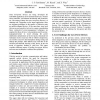Free Online Productivity Tools
i2Speak
i2Symbol
i2OCR
iTex2Img
iWeb2Print
iWeb2Shot
i2Type
iPdf2Split
iPdf2Merge
i2Bopomofo
i2Arabic
i2Style
i2Image
i2PDF
iLatex2Rtf
Sci2ools
DATE
2008
IEEE
2008
IEEE
Test Strategies for Low Power Devices
Ultra low-power devices are being developed for embedded applications in bio-medical electronics, wireless sensor networks, environment monitoring and protection, etc. The testing of these low-cost, low-power devices is a daunting task. Depending on the target application, there are stringent guidelines on the number of defective parts per million shipped devices. At the same time, since such devices are cost-sensitive, test cost is a major consideration. Since system-level power-management techniques are employed in these devices, test generation must be powermanagement-aware to avoid stressing the power distribution infrastructure in the test mode. Structural test techniques such as scan test, with or without compression, can result in excessive heat dissipation during testing and damage the package. False failures may result due to the electrical and thermal stressing of the device in the test mode of operation, leading to yield loss. This paper considers different aspects of testi...
Related Content
| Added | 29 May 2010 |
| Updated | 29 May 2010 |
| Type | Conference |
| Year | 2008 |
| Where | DATE |
| Authors | C. P. Ravikumar, M. Hirech, X. Wen |
Comments (0)

